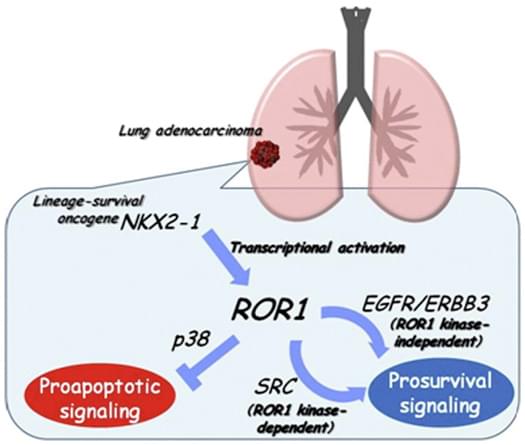All products and services are For Research Use Only and CANNOT be used in the treatment or diagnosis of disease.
Target Background
ROR1 (receptor tyrosine kinase-like orphan receptor 1) is highly expressed in human cells during early embryonic development and exists in a broad spectrum of cancer cells including neuroblastoma, lung adenocarcinoma, gastric adenocarcinoma, chronic lymphocytic leukemia, ovarian cancer, etc., while with very low level of expression in normal adult tissues and tumor-adjacent tissues. Despite the nonessential function of ROR1 in normal adult tissues, cumulative preclinical and clinical studies have shown that increased ROR1 expression manifests an active role in cancer malignant transformation and aggressiveness by promoting cancer cell proliferation, fostering chemotaxis and metastasis. In addition, augment expression of ROR1 enhances resistance to apoptosis of cancer cells induced by cytotoxic agents. These characteristics of ROR1 make it a CAR-T cell target of great potential.

Induced ROR1 sustains EGFR survival signaling in lung adenocarcinoma
Cancer Cell. 2012; 21(3): 348-361
Anti-ROR1 CAR-T Cell Therapy
A clinical trial (NCT01358604) that analyzes the expression of ROR1 on the surface of primary neuroblastoma cells has completed and proves that ROR1 is a suitable biomarker and a novel target for neuroblastoma therapy. Afterwards, a phase 1 clinical trial (NCT02194374) is proceeding to check the effectiveness of autologous ROR1R-CAR-T cells for the treatment of chronic lymphocytic leukemia (CLL). Meanwhile, another phase 1 trial (NCT02706392) studies the side effects and best dose of genetically modified T-cell therapy in treating patients with several advanced ROR1+ malignancies including CLL, mantle cell lymphoma (MCL), acute lymphoblastic leukemia (ALL), stage IV non-small cell lung cancer (NSCLC), or triple negative breast cancer (TNBC) that has spread to other places in the body and usually cannot be cured or controlled with treatment (advanced).
Animal Models for in vivo Study of anti-ROR1 CAR-T Cell Therapy
At the preclinical stage of in vivo ROR1 CAR-T cell therapy studies, Creative Biolabs provides versatile animal models for neuroblastoma, lung adenocarcinoma, gastric adenocarcinoma, CLL, ovarian cancer, etc. either in the subcutaneous or orthotopic pattern. Furthermore, Creative Biolabs could help customers create clinically relevant orthotopic mouse models including but not limited to the following categories.
Xenograft models for malignant ovarian cancer mouse models: subcutaneously or intraperitoneally inoculate human ovarian cancer cell lines including A1847, A2780l-luc, ES-2, HO-8910PM, PA-1, IGR0V1, OVCAR-3, OVCAR-5, SK-OV-3 and TOV-21G into NSG mice.
Allograft models for neuroblastoma: transgene mice with simian virus 40 T-antigen gene (control tool: tetracycline responsive elements with cytomegalovirus promoter), some lines exhibiting bilateral adrenal tumors due to leakage expression of T-antigen in adrenal gland and check the following characteristics:
Creative Biolabs confirms all the positive characteristics of neuroblastoma.
Lung adenocarcinoma mouse models: orthotopically injection of H1299 cells into the left lung of NSC mice or intravenously injection with A549 cells to form metastatic models.
In vivo Assay Parameters and Techniques
At Creative Biolabs, we offer the most exquisite and comprehensive service platform for preclinical ROR1 CAT-T cell therapy research.
Efficacy Test
Tumor remission monitored by tumor volume recording or bioluminescence imaging and survival curve tracking
Viability and Bio-distribution Studies
Durability, GLP-compliant bio-distribution studies
Toxicity Evaluation
Pilot tolerability (MTD, The route of administration, Dose regimen/response/onset)
Clinical observation (body weight, feed consumption, ophthalmologic and clinical pathology)
Cytokine storm surveillance (fever, hypertension, prolonged cytopenia)
Complete necropsy, organ weight
Histopathology
Tumorigenicity study
Creative Biolabs could provide the most reliable and relevant animal models to accomplish challenging preclinical studies. Furthermore, we could fulfill any individualized requirements and help model the most scientific design.
References
For any technical issues or product/service related questions, please leave your information below. Our team will contact you soon.
 NEWSLETTER
NEWSLETTER
The latest newsletter to introduce the latest breaking information, our site updates, field and other scientific news, important events, and insights from industry leaders
LEARN MORE NEWSLETTER NEW SOLUTION
NEW SOLUTION
CellRapeutics™ In Vivo Cell Engineering: One-stop in vivo T/B/NK cell and macrophage engineering services covering vectors construction to function verification.
LEARN MORE SOLUTION NOVEL TECHNOLOGY
NOVEL TECHNOLOGY
Silence™ CAR-T Cell: A novel platform to enhance CAR-T cell immunotherapy by combining RNAi technology to suppress genes that may impede CAR functionality.
LEARN MORE NOVEL TECHNOLOGY NEW SOLUTION
NEW SOLUTION
Canine CAR-T Therapy Development: From early target discovery, CAR design and construction, cell culture, and transfection, to in vitro and in vivo function validation.
LEARN MORE SOLUTION